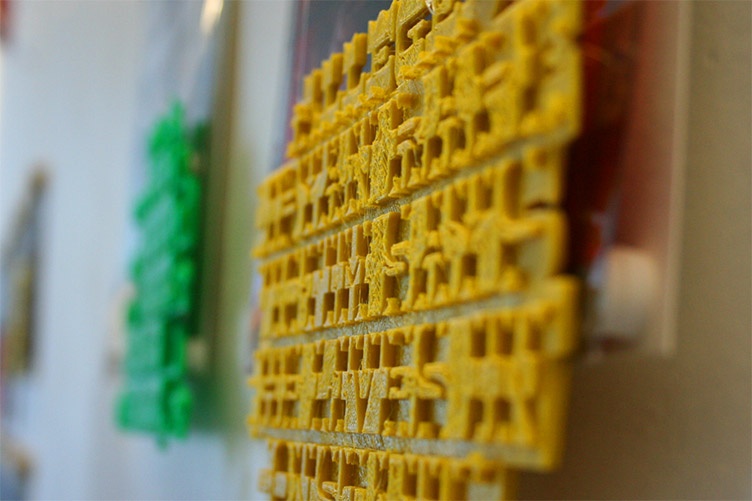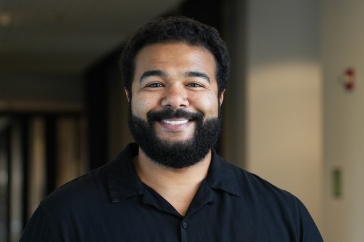
A piece from Liese Zahabi’s tile and mixed-media installation, An Exquisite Morass Made Tangible, exhibited at Eastern Michigan University and Eastern Illinois University.
“Design creates culture. Culture shapes values. Values determine the future.” — Robert L. Peters, designer and author
“Design is not just what it looks like and feels like. Design is how it works.” — Steve Jobs
You get the picture. Design has become an increasingly valued and necessary element for businesses and organizations around the globe. Designers help create effective and engaging products, services, environments and companies. At the same time, “users and consumers” (aren’t we all?) are subjecting the messages, products and organizations they encounter to greater degrees of scrutiny, if not outright skepticism.
Creative to the Core
The design studies core consists of six courses. All majors and minors take Principles of Design, and majors take at least four other core courses. Other course options draw from studio arts, communication, history, computer science, IT, education and other fields to form highly personalized, interdisciplinary study.
ARTS 510: Principles of Design
ARTS 610: Principles of Typography
ARTS 612: Interaction and Game Design
ARTS 611: Animation and Motion Design
ARTS 613: Design and Place
ARTS 614: Design and People
This is a good thing for the world and an even better thing for aspiring designers. More than ever, we need people who can not only create innovative and visually striking designs, but also know how to lead groups of collaborators, conduct research and make work that engages people in the things they want to do. Liese Zahabi calls this “human-centered design,” and it aptly expresses the philosophy that guides the University’s growing design studies program.
In fall 2018, COLA hired assistant professor of art Liese Zahabi as the college’s first design professor. She has created an interdisciplinary design studies concentration and design studies minor featuring a slew of courses tailored to the needs of students who want to pursue careers in design.
Zahabi’s own background is in graphic design. She did both her undergraduate and graduate work in the field and has been working as a commercial designer for over 20 years. She’s had a front seat to the pivot her profession has undergone over that period. “First, the switch from print to digital mediums in the 2000s has meant that the traditional focus on typography and layout has switched to interactive design: how we communicate and use the things we make in the digital space,” says Zahabi.
Second, as the digital tools became easier and easier to use, designing grew more “democratized.” Gradually, not everybody needed a designer for their block and tackle projects. “As a result,” says Zahabi, “professional designers are pivoting to human-centered design as a means of finding new ways of contributing and enhancing their value,” says Zahabi.
What Zahabi calls “upper-case design” moves beyond images and words. “Instead of putting the technology or information or object first, you put people first and see what they need and how they will use these elements. Instead of making something by yourself, you engage others in coming up with what you need and then go off and make the thing,” Zahabi explains.
Accent on interactive

Project REBORN
"Design and People is a class tailored to designing projects and systems that help to benefit the general public. For this specific project, we were tasked with designing a program or facility that would aid in helping a local issue. I focused on the heroin epidemic in New Hampshire, specifically the transition to life outside of rehab. I was able to determine which resources were lacking and included those in my program.
"The program I designed, REBORN, would provide assistance with job searching and interview prep, access to affordable and safe housing, childcare for those who have children to take care of and other kinds of help. This was a very fulfilling project because I designed the company’s branding as well as its programs, all to meet the needs of my audience."
– Shannon Riley ’21
Jennifer Moses, professor and chair of art and art history, says that UNH has always graduated strong artists who have found success as designers as well as working artists and teachers. “The big difference, and the reason we started the design program, is that commercial firms used to look for creative people and then train them in the software. Today, companies like it when you come to them with greater proficiency in the tools.”
Using the Adobe Creative Suite (Photoshop, Illustrator, InDesign, AfterEffects, etc.), mobile-app prototyping, animation and website coding software, design students get hands-on experience creating graphic design, visual communication, logo design, typography, print design, web design, interactive design, mobile app design, game design, user experience design, wayfinding and signage, and social media design.
“By the time they leave the program,” says Zahabi, “they’ll have had an array of creative experience and put together a comprehensive portfolio.”

Sydney Whittum ’21, a studio arts major who is concentrating in design studies, has always wanted to be an interior designer. Now, thanks to the design studies program, she can pursue her dream. To date, she’s designed her own restaurant interior, including menus and signage, which she says, “was pretty cool,” and made a book of charcoal drawings and narratives done by artist and UNH football coach Tim Churchard.
Her course work has enabled Whittum, who interns with an interior design group in Exeter, N.H., to move from manning the phones to doing actual design work, stoking her passion for making a career out of the skills she’s acquiring. “I want to be able to do something creative with my entire life,” Whittum says. “Design is flexible, and I could go into advertising, marketing, interior design, photography and content creation. Design studies can open lots of different pathways.”
Shannon Riley ’21, a communication major, is taking design courses to “round” herself out as a content creator. “I come from more of a writing background,” she says, “but by adding design, I have more tools at my disposal to tell stories that attract the right audience.”
-
Written By:
Dave Moore | Freelance Writer

















































